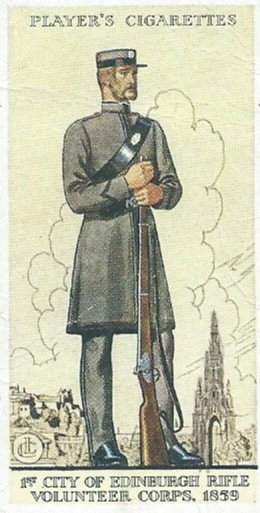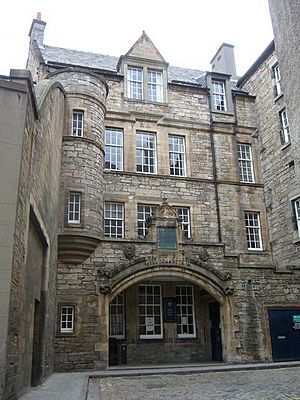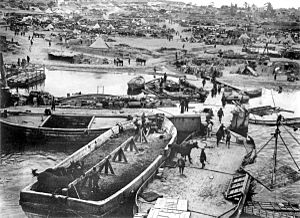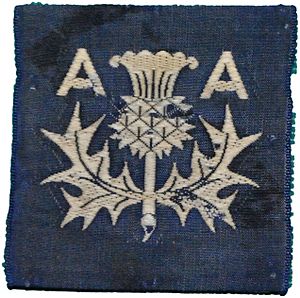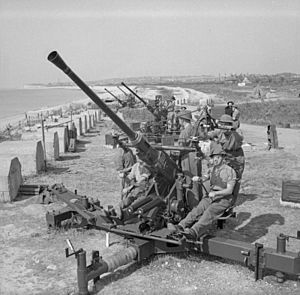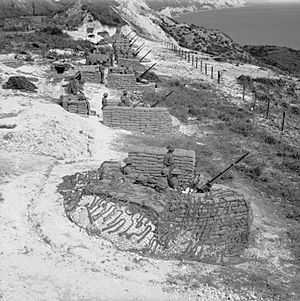Queen's Edinburgh Rifles facts for kids
Quick facts for kids Queen's Edinburgh Rifles4th/5th (Queen's Edinburgh Rifles) Battalion, Royal Scots 52nd (Queen's Edinburgh, Royal Scots) S/L Rgt, RA 130th (Queen's Edinburgh, Royal Scots) LAA Rgt, RA 587 (Queen's Edinburgh, Royal Scots) LAA Rgt, RA |
|
|---|---|
| Active | 31 August 1859 – 1 May 1961 |
| Country | |
| Branch | |
| Role | Infantry Air Defence |
| Part of | 52nd (Lowland) Division 29th Division 32nd Division 65th (2nd Lowland) Division Anti-Aircraft Command |
| Garrison/HQ | Edinburgh |
| Colors | Hunting Stuart Tartan (Pipers, Royal Stewart) |
| March | I'm Ninety-Five |
| Engagements | Second Boer War World War I:
|
| Commanders | |
| Notable commanders |
James, Lord Moncrieff John Macdonald, Lord Kingsburgh Sir Robert Cranston |
The Queen's Edinburgh Rifles was a group of volunteer soldiers formed in Edinburgh in 1859. These volunteers wanted to help defend their country. Later, they became two battalions of the Royal Scots regiment. These battalions fought bravely in World War I in places like Gallipoli, Palestine, and on the Western Front.
After World War I, the two battalions joined together. Before World War II, they changed their role to become an air defence unit in the Royal Artillery (RA). This unit helped protect Britain from air attacks during World War II. It continued to serve in the Territorial Army until 1961. After that, its members became part of the Royal Engineers (RE).
Contents
Volunteer Soldiers: The Early Years
In 1859, many people in Britain were worried about a possible invasion. This led to a huge wave of enthusiasm for joining volunteer groups. These groups were made up of part-time soldiers who wanted to support the regular British Army.
The 1st City of Edinburgh Rifle Volunteer Corps (RVC) was one of these groups. It was formed on August 31, 1859. It had 21 different companies, each made up of people from different jobs or interests in Edinburgh. For example, there were companies of lawyers, accountants, and even students from Edinburgh University.
Some companies paid for their own uniforms and gear. Others, like the bank clerks and tailors, got financial help from their employers. A famous author, R. M. Ballantyne, even served as a captain in one of the companies!
In 1865, the unit was renamed the 1st Queen's Edinburgh Rifle Volunteer Brigade (1st QERVB). It kept growing, adding more companies. By 1869, it was so large that it split into two battalions. This made it the biggest Rifle Volunteer Corps in the entire Volunteer Force. The unit's main base was at the Forrest Hill drill hall in Edinburgh.
A key leader was John Macdonald, Lord Kingsburgh. He was a Lieutenant-Colonel and pushed for better training methods. In 1885, he organized a huge night event for the brigade, which helped them get 500 new recruits!
Becoming Part of the Royal Scots
In 1881, the 1st QERVB became two Volunteer Battalions of the Royal Scots regiment. This was part of a big army reform to link volunteer units with regular regiments. They were officially called the Queens Rifle Volunteer Brigade Royal Scots.
Fighting in the Boer War
Members of the brigade volunteered to serve in the Second Boer War in South Africa (1900–1902). They fought alongside the regular soldiers. In total, 245 members of the brigade served in this war. Their bravery earned them their first special honor: South Africa 1900–02.
After the war, the brigade continued to grow. In 1900, a new Highland Battalion was formed, made up of eight companies wearing traditional Scottish kilts. This battalion later became the 9th Battalion, Royal Scots.
Territorial Force: A New Era
In 1908, the Volunteer Force was changed into the new Territorial Force (TF). The three battalions of the Queen's Edinburgh Rifles were reorganized. They became the 4th and 5th Battalions of the Royal Scots. Both were given the special name 'Queen's Edinburgh Rifles'.
These two battalions stayed in the Lothian Brigade. Their main job was to help defend the coast.
World War I: Global Conflict
Getting Ready for War
When World War I started on August 4, 1914, the Lothian Brigade quickly got ready in Edinburgh. Many soldiers volunteered to serve overseas. To prepare, new "2nd Line" units were created for those who wanted to go abroad. Later, "3rd Line" training units were formed to provide new soldiers.
1/4th (QER) Royal Scots: From Gallipoli to the Western Front
The 1/4th (QER) Battalion, Royal Scots, joined the 52nd (Lowland) Division and headed for Gallipoli in May 1915.
Gallipoli: A Tough Fight
The battalion landed at 'W' Beach in Gallipoli. They immediately started digging trenches under enemy fire. They fought bravely, even taking turns in the front line. In one battle, the Battle of Gully Ravine, they attacked Turkish trenches. The fighting was very fierce, and they suffered many casualties, including their commanding officer.
After Gallipoli, the exhausted battalion was evacuated to Egypt. Only a small number of the original soldiers remained.
Egypt and Palestine: Desert Warfare
In Egypt, the 52nd (Lowland) Division helped defend the Suez Canal. The 1/4th Royal Scots saw some action during the Battle of Romani in August 1916, but the main attack was stopped by British artillery.
Later, they moved into Palestine. They fought in the 2nd Battle of Gaza in April 1917, where they faced heavy shellfire. In November 1917, during the 3rd Battle of Gaza, the 4th Royal Scots (the '1/' was dropped as other battalions were gone) had a very difficult task. They had to cross a large open area and attack a strong Turkish fort called the el Arish redoubt. They practiced for days and then attacked at night, advancing steadily under fire and capturing the fort.
They continued to advance, fighting in the hills and crossing the Nahr el Auja in December 1917. This river crossing was considered one of the most amazing achievements of the Palestine Campaign.
Western Front: The Final Push
In early 1918, the 52nd (Lowland) Division moved to the Western Front in France. They joined the British Expeditionary Force.
They took part in the Hundred Days Offensive, the final push against the German army. In August 1918, the 4th Royal Scots attacked near Mercatel, taking their objectives quickly. They continued to fight in battles like the Battle of the Scarpe and the Battle of Drocourt-Quéant Line, where they captured strong German defenses with surprising ease.
In September, they fought at the Canal du Nord, a major obstacle. They bravely crossed the dry canal and captured their objectives. The battalion continued to advance, clearing German forces until the Armistice with Germany on November 11, 1918, which ended the war.
1/5th (QER) Royal Scots: Gallipoli and Beyond
The 1/5th (QER) Battalion, Royal Scots, joined the 29th Division and sailed for Gallipoli in March 1915. They landed at V Beach on April 25, facing heavy fire. They suffered many casualties, including their commanding officer, in the fierce fighting around Achi Baba Ridge.
The battalion was so weakened that it was sent to Mudros for rest. After being reinforced, it returned to Gallipoli for more trench duty before being moved to Egypt in October. In March 1916, they sailed to France to join the British Expeditionary Force on the Western Front.
5th/6th Royal Scots: Amalgamation and Final Battles
In France, the 1/5th Royal Scots was very weak. In May 1916, it joined with the 1/6th Royal Scots to form the 5th/6th Battalion. This new combined battalion then joined the 32nd Division.
They fought in the final stages of the Battle of the Somme in November 1916. In 1917, they followed the German retreat to the Hindenburg Line and captured Holnon Wood.
In 1918, they faced the German Spring Offensive and helped stop it. They then took part in the Allied Hundred Days Offensive. They fought in the Battle of Amiens and the Battle of the Scarpe. In September, they bravely crossed the Somme Canal and river, clearing the village of Brie.
Their last major battle was the Battle of St Quentin Canal in October. They fought hard to capture the village of Sequehart, which changed hands four times before they finally secured it. The battalion continued to advance until the Armistice on November 11, 1918. They were part of the occupation force in Germany before returning home in 1919.
Between the Wars: A New Role
After World War I, the Territorial Army was reformed. In 1921, the 4th and 5th (QER) Battalions of the Royal Scots combined to form a single unit: the 4th/5th (Queen's Edinburgh Rifles) Bn, Royal Scots.
Becoming an Anti-Aircraft Unit
In the 1930s, Britain needed better air defense for its cities. Many infantry battalions in the Territorial Army were changed into anti-aircraft (AA) units. The 4th/5th (QER) Royal Scots was one of these.
On November 1, 1938, it became a searchlight (S/L) regiment in the Royal Artillery. Its new name was 4th/5th (Queen's Edinburgh) Bn The Royal Scots (The Royal Regiment) (52nd Searchlight Regiment). This unit was based at the Forrest Road drill hall.
World War II: Defending the Skies
52nd (Queen's Edinburgh, Royal Scots) Searchlight Regiment
At the start of World War II, the regiment was part of 3 AA Division, which covered Scotland. They were involved in the first air raid against the UK on October 16, 1939, when German planes attacked the Rosyth Dockyard near the Forth Bridge.
In August 1940, all searchlight regiments came under the control of the Royal Artillery. The unit was then called the 52nd (Queen's Edinburgh, Royal Scots) Searchlight Regiment, RA. They continued to defend eastern Scotland from air attacks.
130th (Queen's Edinburgh, Royal Scots) Light Anti-Aircraft Regiment
By 1942, there were enough searchlight units, but more light anti-aircraft (LAA) gun units were needed. So, in March, the 52nd S/L Regiment was changed into an LAA gun unit. It became the 130th (Queen's Edinburgh, Royal Scots) LAA Rgt.
Operation Diver: Fighting V-1 Flying Bombs
The 130th LAA Regiment was stationed on the Kent coast, a dangerous area known as 'Hellfire Corner' because of frequent German shelling. In June 1944, Germany began launching V-1 flying bombs, also called 'Divers', towards London.
The regiment was part of Operation Diver, a plan to shoot down these missiles. Their guns were constantly firing, and they became very good at hitting the V-1s. They helped destroy over 50 percent of the incoming missiles. This effort continued until the V-1 launch sites in France were captured by Allied forces. The regiment remained active until the end of the war.
After the War: Changes and Amalgamations
When the Territorial Army was reformed in 1947, the regiment became the 587 (Queen's Edinburgh, Royal Scots) LAA Rgt.
In 1955, there was a big reduction in the number of anti-aircraft units. The 587 LAA Rgt merged with several other units to form a new 432 LAA Rgt. This new regiment included a battery named P (Queens Edinburgh, Royal Scots) Battery.
In 1961, the 432nd LAA Rgt was transferred to the Royal Engineers (RE). It joined with other engineer units to form the 432 (City of Edinburgh) Corps Engineer Regiment. Later, in 1967, this regiment was reduced to a single squadron, the 104 (City of Edinburgh) Field Squadron, which was finally disbanded in 1999.
Uniforms and Traditions
The Queen's Edinburgh Rifles had interesting uniforms. At first, they wore dark grey tunics and trousers. Their Highland companies wore grey doublets and kilts of the Black Watch tartan. Each company even had a different cap badge!
Over time, their uniform changed. They adopted a black busby (a tall fur hat) like the Rifle Brigade. By 1908, they switched to the red uniform tunic with blue facings of the Royal Scots. Their regimental tartan was Hunting Stuart, and their pipers wore Royal Stewart tartan.
In 1943, the 130th LAA Rgt wore a black silhouette of the Royal Scots cap badge as a special patch. Later, the 587th LAA Rgt adopted a black silhouette of a Thistle head on a brown square.
The unit also had a band from early on, playing the march I'm Ninety-Five. The Highland companies had pipers, and there was also a bugle band.
Important Leaders
The Lord Provost of Edinburgh (the city's mayor) was always the honorary head of the Queen's Edinburgh Rifles. Other important leaders included:
- James Moncreiff, 1st Baron Moncreiff: The first Lieutenant-Colonel Commandant from 1859 to 1873.
- John Macdonald, Lord Kingsburgh: A Lieutenant-Colonel Commandant from 1882 to 1892, known for improving drill training.
- Garnet Wolseley, 1st Viscount Wolseley: A very important general who later became the Commander-in-Chief of the British Army.
Remembering Their Service
All Royal Scots soldiers who died in World War I are remembered at the memorial gates at Glencorse Barracks in Penicuik. These gates were designed by J.A. McWilliam, who was a member of the Queen's Edinburgh Rifles.
The special flags, or colours, of the 4th/5th Battalion from 1925 to 1938 are kept safe in the Royal Scots Regimental Museum at Edinburgh Castle.
A special Masonic Lodge, Queen's Edinburgh Rifles (The Royal Scots) No 1253, was created in 1921. It was set up to remember the members who died in World War I. The Lodge still meets today and continues its role as a memorial.
Images for kids
-
90 cm 'Projector Anti-Aircraft', displayed at Fort Nelson, Hampshire.
External sources
- Mark Conrad, The British Army, 1914 (archive site)
- British Army units from 1945 on
- Electric Scotland
- Great War Forum
- The Long, Long Trail
- Orders of Battle at Patriot Files
- The Regimental Warpath 1914–1918 (archive site)
- Land Forces of Britain, the Empire and Commonwealth (Regiments.org – archive site)
- Royal Artillery 1939–1945
- The Royal Scots
- Scottish Military History
- Graham Watson, The Territorial Army 1947


